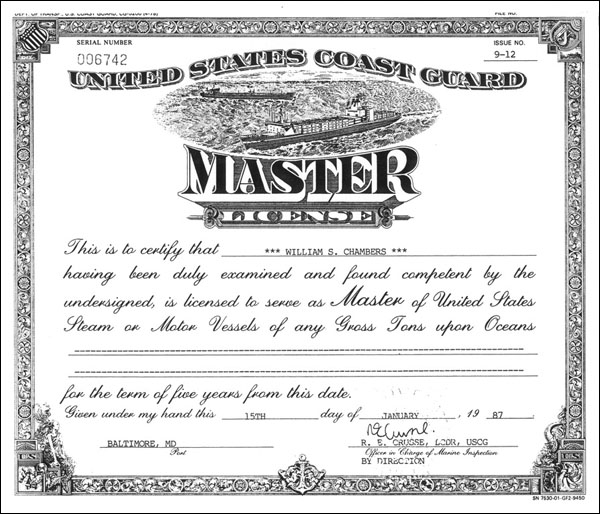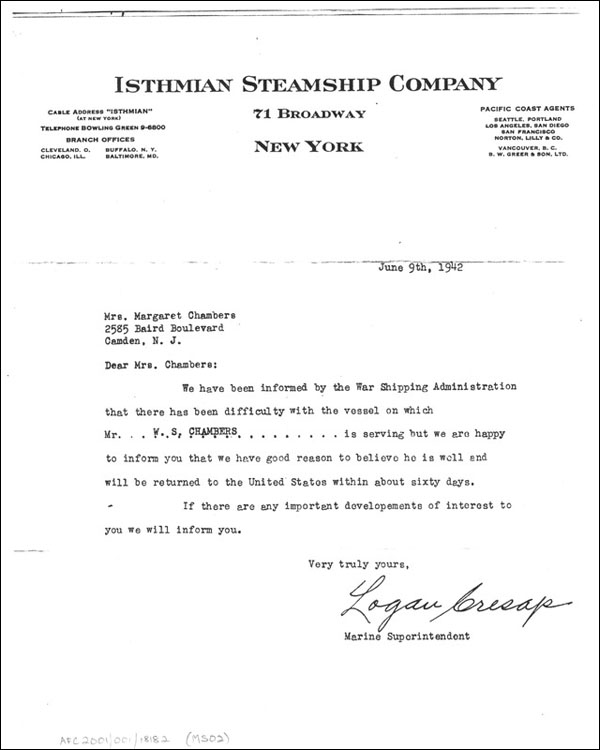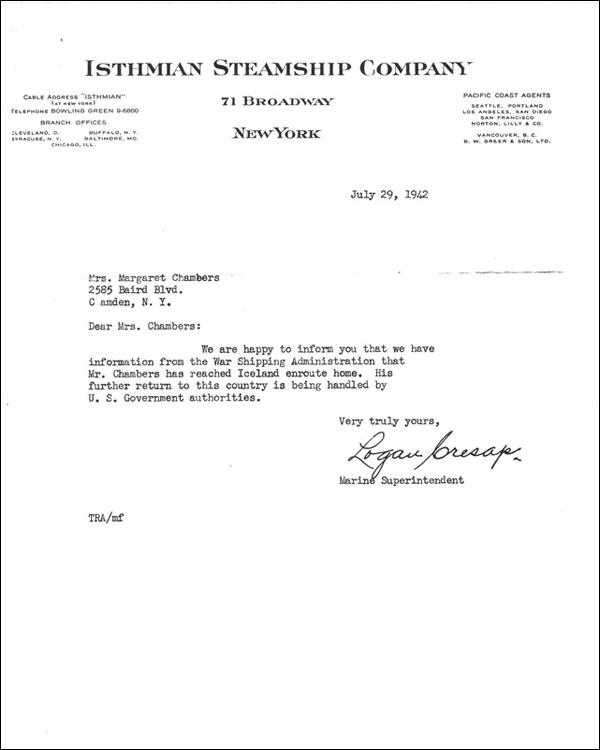Capt. Chambers was in the steamship business in one capacity or another from 1939 until he
retired in 1992. His last voyage as a merchant marine officer was probably in 1946.
After he graduated from MIT he worked for steamship companies in Havana Cuba and NYC.
Later he went to work for the United States Maritime Administration where he retired
as Director of the Southeast Region of the Maritime Administration.
[Note... The following information and more can be found at the
Veterans History Project
of The Library of Congress.]
"William Chambers was en route to Hawaii on a cargo ship on December 7, 1941, when his captain
announced news of the attack on Pearl Harbor. Chambers had been in effect training for war
for two years. At 18, he entered the Pennsylvania State Nautical School in October 1939,
shortly after WWII broke out in Europe, and the school had its students learn the ropes on
different vessels of the U.S. Navy. During the war, Chambers made many dangerous voyages,
none worse than a 1942 trip to the Soviet Union on which he lost three ships to torpedoes
or mines. At war’s end, he was still at sea, carrying supplies for the invasion of Japan
which were never needed."
[Note... The following is an excerpt from a 2004 interview of Capt. Chambers for the Veterans History Project.]
"...
Kathryn Chambers Torpey:
Your first voyage as Junior Third Mate was on the SS Steelmaker. You were on board that vessel
when the war started. Please tell me about that voyage.
William S. Chambers:
Well, the SS Steelmaker was a cargo ship owned by the Isthmian Steamship Company. We were on a
commercial voyage en route from New York via the Panama Canal to Honolulu. While eating
breakfast before going on the eight to twelve morning watch, the Captain came into the officers
saloon and announced the receipt of a radio message from the U.S. Navy San Francisco to the
effect that Japan attacked Pearl Harbor a few hours earlier and we were to follow sealed orders
the Captain had received in Panama. Upon arrival in Honolulu Harbor on December 15th, we only
heard rumors about what had happened. We were not allowed to see the damage in Pearl Harbor
nor around any other parts of the waterfront. The longshoremen where Japanese. They were
under guard of the military at the time. We were allowed off the ship, but only on the pier
and in the very near vicinity. We were not allowed to go into Honolulu. We returned to San
Francisco in a convoy, which was the first convoy I had experienced. We had a U.S. Navy
signalman on board for communication with other ships. We were shelled by a Japanese
submarine in Kahului Harbor on December 30th, 1941, shortly before we left for San Francisco.
Kathryn Chambers Torpey:
During the rest of the war you sailed in various convoys. Please describe the nature of a convoy.
William S. Chambers:
In a convoy each ship flies a number and the number is visible to all the other ships in the
convoy. For example, if the ship was number fifteen that means the ship was in column one and
row five of the convoy. The convoy commander was a high ranking Naval officer on the lead
merchant ship. The convoy commander would send signals or messages to the other ships and
the other ships were to keep in position on station and be ready to receive orders from the
convoy commander at any time. As to the course and distance and speed and maneuvering,
instructions in the event of an attack, were constantly going back and forth.
Kathryn Chambers Torpey:
Your first voyage in a convoy across the North Atlantic was on the SS Steel Worker
which was also owned by the Isthmian Steamship Company. You were a Third Mate. The ship
departed from Philadelphia on March 26, 1942, en route to Murmansk, Russia. Please tell
me about that voyage.
William S. Chambers:
Our ship was loaded with cargo for Russia including 250 tons of explosives. The explosives
were in number five hatch which is at the stern of the ship. The ship was armed with machine
guns to be used by the merchant seaman. There was no U.S. Navy armed guard on board only two
U.S. [Navy] signalmen for communications purposes with the other ships and the convoy
commodore. According to my notes, from May 25th to May 31st we were under continuous air
attack. My notes say that 8 ships were sunk, 3 were hit and made port, many damaged from near
hits, 4 enemy planes were destroyed, and many were damaged. When we finally arrived at our
destination in Murmansk, we unloaded the 250 tons of explosives straight away. On our way to
discharge the remaining cargo for Russia at another berth in this great Kola Inlet a heavy
explosion hit number fivehatch which had been loaded with explosives. The ship sank on
June 3, 1942, while navigating through the Kola Inlet. It may have struck a mine, we don't
know. It struck (sic) [sank] in the half an hour. We abandoned ship by the ship's lifeboats
and a British escort vessel picked us up and took the transferred crew members to the
SS Alcoa Cadet. Russian divers subsequently reviewed the cargo plans for the SS Steel Worker
and were able to salvage much of the cargo that could be of military use because the ship
had sunk in water that was less than 100 feet deep. The SS Alcoa Cadet had completely
discharged its cargo and was waiting for orders to proceed to another port or perhaps
back to the United States. As far as the sinking of the ship is concerned [i.e., the
SS Alcoa Cadet which sank on June 21, 1942], the British said it was a mine and the
Russians said it was a torpedo. We could have been... It could have been a mine dropped
from a German plane. I was standing beside my desk in my office (sic) [cabin] when the
ship blew up. I was rescued from a life raft along with the Captain of the ship by a
Russian patrol craft and transferred to a Russian military barracks across the river
from Murmansk. I remember that I had gotten my first wristwatch when I graduated from high school.
Both my wristwatch and my original seaman's certificate and other papers went down with
the SS Steel Worker on June the 3rd, 1942.
..."
|









